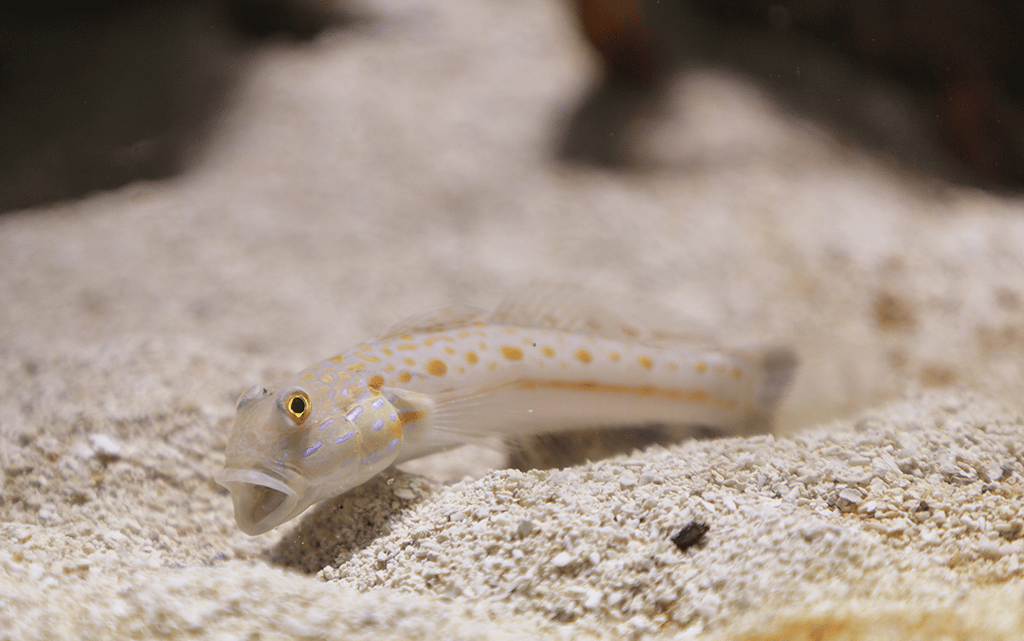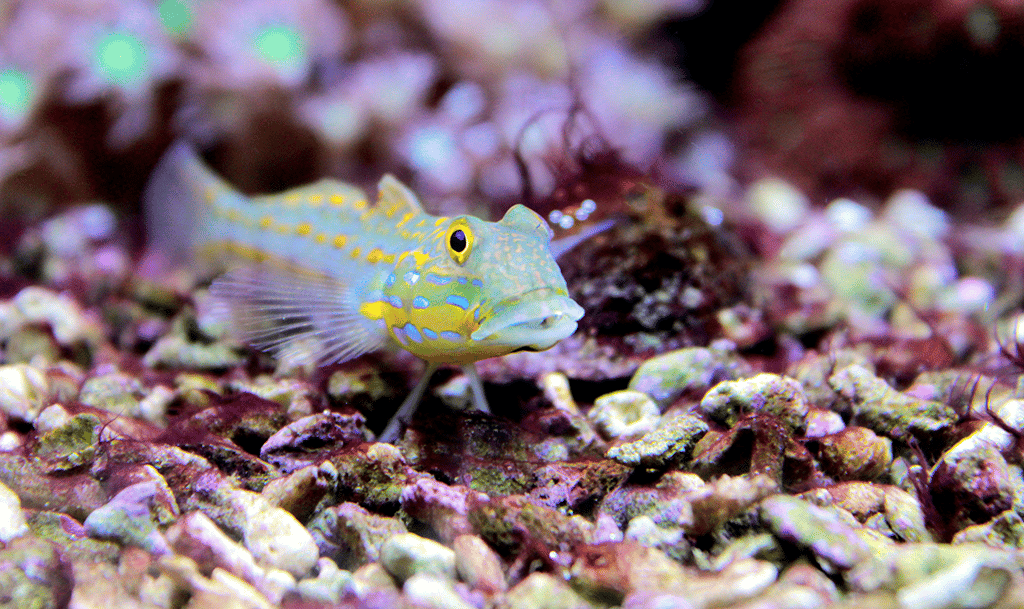Chalice Coral: A Comprehensive Guide for Beginners
Corals are not just beautiful creatures that add color to an underwater world, but they also play a vital role...
Jim Sabellico
July 5, 2022

6 inches
30 Gallons
Day
3 to 5 years
Meaty foods
White, Yellow, Orange
Easy, great for beginners
Peaceful
Yes
Bottom
Looking for a care guide for diamond goby? In this blog post, we will discuss everything you need to know about taking care of this fish. We will cover topics such as feeding, tank size, and water parameters. We will also provide some helpful tips on how to keep your diamond goby healthy and happy!
Some of its common names are diamond watchman, orange-spotted goby, and diamond sleeper goby, while the scientific name of Diamond Goby is Valenciennea puellaris.
The diamond goby is a small fish that is found in the reefs of the Indian and Pacific Oceans. It gets its name from the unique diamond-shaped markings on its body. This fish is a common sight in saltwater aquariums, where it is often used to help control algae growth.
Diamond goby’s has a semi-translucent white body with a few lines running vertically down their bodies. They have a large head in comparison to their body, and their eyes are large.
These species have both a spiny and a soft dorsal fin, they are typically shy fish that prefer to remain hidden among the rocks or coral.
Diamond goby typically costs somewhere in the $30-$45 range. However, prices can vary depending on factors such as the fish’s size, coloration, and overall quality.
Some diamond gobies may even be priced higher than $45 if they are particularly rare or exotic-looking. So, if you’re interested in purchasing a diamond goby, be sure to shop around and compare prices before making your final decision.
The recommended tank size for a diamond goby is at least 30 gallons. However, if you are planning on keeping more than one fish, you will need a larger tank.
Diamond gobies are relatively tolerant of different water conditions. pH levels should not be lower than 8.5 or 8.1 and specific gravity must be 1.020 to 1.025
An ideal temperature range for these fish is between 75-82 degrees Fahrenheit. Since the Diamond Gobby is an active fish, you need to have a strong sump or refugium to provide it the nutrients it needs when feeding. It is crucial that the water in your fish tank be changed at least every two weeks.
Diamond goby is a carnivorous fish, which means they require a diet that is high in protein. They should be given a variety of frozen and live foods such as brine shrimp, mysis shrimp, copepods bloodworms, and live blackworms.
It is also a good idea to supplement their diet with vitamin-enriched flake food or pellets. Be sure to feed your diamond goby several small meals throughout the day, rather than one large meal.
Be careful not to overfeed your fish, as this can lead to health problems such as obesity and digestive issues.
Diamond gobies are relatively easy to breed in captivity. They typically reach sexual maturity at around six months of age.
To encourage breeding, it is best to keep a ratio of one male to two females. The males will often build nests out of sand or rubble in order to attract a mate.
Once the female has laid her eggs, the male will fertilize them and then care for them until they hatch. The fry (baby fish) will be able to eat small live foods such as copepods and newly hatched brine shrimp.
They are not fussy eaters, and will accept most freeze-dried, frozen, and live foods. Many reefers like to supplement their diet with copepods and amphipods, which often inhabit live rock in reef tanks. In the wild, these types of small crustaceans make up the majority of their diet. Feeding 2-3 times per day is sufficient.
It’s best to feed small amounts at a time so that everything is eaten. Gobies have small mouth, so they can’t eat very large pieces of food. If you’re using freeze-dried or frozen foods, make sure to soak them in some tank water beforehand, so they’re softer and easier to eat.
Diamond Golby can be a valuable asset because they help keep the algae levels in check, but keeping them healthy in a reef tank can be a challenge. Fortunately, there are a few things you can do to help keep your diamond goby healthy in your reef tank:

Make sure you are providing enough food for your goby. Diamond gobies typically eat small invertebrates such as brine shrimp, so make sure you are feeding your fish a varied diet that includes plenty of live prey.
Your tank should be well-lit and the water is properly filtered. Diamond gobies prefer tanks with moderate to high levels of lighting and good water flow.
They prefer tanks with moderate to high levels of lighting and good water flow. Finally, be sure to keep an eye on the water temperature and pH levels in your tank, as both of these factors can affect the health of your diamond goby.
Gobies are a popular fish for home aquariums, and the diamond gobby is a particularly striking variety. This fish does best when kept in small groups, so if you’re thinking of adding one to your tank, it’s important to choose the right tank mates. Here are some suggestions for suitable companions for your diamond gobby.
When it comes to selecting a compatible species to keep with the diamond goby, there are a few things to take into consideration. Unfortunately, not all fish make suitable tank mates. Here are the species you need to avoid:
We get a lot of questions about diamond goby, so we’ve compiled a list of the most frequently asked questions to help you care for your fish.
While it’s possible to keep more than one diamond goby in a single tank, it’s not recommended. These fish are known to be aggressive towards each other, and they will often fight to the death. If you do decide to keep more than one diamond goby, be sure to provide plenty of hiding places and rocks for them to claim as their own territory.
The average lifespan of a diamond goby is between three and five years. However, with proper care, it is not unusual for these fish to live for six years or more.
No, diamond gobies do not require a sand bed. In fact, they prefer to live in areas with plenty of rocks and hiding places. A sand bed can actually be dangerous for these fish, as they are known to burrow into the sand and then get stuck.
Diamond gobies typically reach a length of about four inches. However, they can grow up to six inches in some cases.
It’s a common question for those who are thinking about getting a diamond goby – do they jump? The answer is yes, they can jump. However, it’s not something that they do often, and usually, only happens when they’re startled or frightened.
Jumping isn’t the only way that diamond gobies can escape from predators or other threats – they’re also good swimmers. In fact, they’re so good at swimming that many people keep them as pets in aquariums.
If you’re thinking about getting a diamond goby, just be sure to put a lid on the aquarium to prevent any potential Jumping surprises!
Yes, diamond gobby can get ich. It is a common disease that can affect both fresh and saltwater fish. It’s caused by a parasite that enters the fish’s body and attaches itself to the gills, skin, or fins. Symptoms of ich include lethargy, loss of appetite, and white spots on the fish’s body.
If your diamond goby is displaying any of these symptoms, it’s important to take action immediately. The best way to treat ich is to raise the temperature of the water in your tank and add a saltwater treatment. You can also remove any infected fish from the tank and quarantine them in a separate aquarium.
No, diamond gobies are not hard to keep. In fact, they’re one of the easier species of fish to care for. As long as you provide them with suitable habitat and keep an eye on water quality, they should do well.
You now have the care guide for diamond gobies in a reef tank. Remember to give them plenty of hiding places and keep an eye on water quality. If you follow these simple steps, your fish should thrive and you can expect 3 to 5 years of enjoyment from your little diamond gobby buddies.

I am the founder of J. Louis, a digital marketing agency focused on providing innovative solutions and strategies built on a foundation of creative design and technology. A family man who loves travel and reef tanks, I’ve been coined as a jack of all trades, master of a few of them, most specifically website and sales funnel design, monetization and growth strategies, and viral marketing. I began pursuing my passions for business by cutting my neighbor’s lawns when I was just 8 years old and never looked back. Over the past 20 years, I have amassed significant experience providing consulting, design and development services for Fortune 500 companies, government, retail, private individuals, and A-list celebrities.
Corals are not just beautiful creatures that add color to an underwater world, but they also play a vital role...
As we move into the new year, it's time to start thinking about what reef tank LED lighting kits will...

Proceeds from all purchases go directly to Great Barrier Reef Foundation and supporting their mission.
Want to stay connected with all the latest news in the Reef Tank Addict community? Drop your email below!
Proudly Supporting The Great Barrier Reef Foundation
Copyright © 2023. All rights reserved.